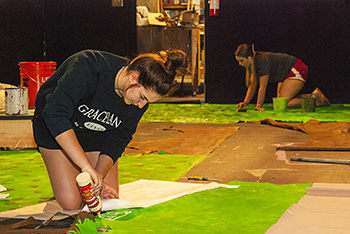Big spaces in “Figaro” bring special challenges for set creator, crew at Felten-Start

04/02/19
HAYS, Kan. – Four acts. Four different locations – Figaro’s quarters, the countess’s boudoir, a banquet hall, and a garden. A cast of 27, not counting stage manager and crew.
All of this in a theatre with limited wing space – that’s the space off to the sides, where actors and scenes wait their turns to be rolled onto the stage.
And a kicker: “We have an unusual challenge with this year’s opera – a three-week turn-around. We usually have six,” said Debra Holmes, assistant professor of music and theatre and technical director for Felten-Start Theatre in Malloy Hall, where Mozart’s “The Marriage of Figaro” will be performed on three nights, Thursday, Friday and Saturday, and a Sunday matinee.
The three week-six week window is the time between tearing down the set for one production – in this case, “Barefoot in the Park” – and building all the scenery and props and designing the lighting for the next one.
Holmes has a Master of Fine Arts in scenography design from the University of North Carolina-Greensboro. That encompasses scenery, lighting and costumes. She is in her first year at Fort Hays State and is also the set designer and chief builder for FHSU Theatre.
“When I was considering the design,” she said, “I needed to include a window for an actor to jump out of, three doors, and some levels, meaning different levels of the stage, to make it interesting, all while keeping the majority of the space clear for bodies.”
Twenty-seven people, plus stage manager and crew, are a lot of people for a stage the size of Felten-Start’s.
“The challenge to this design,” she said, “is to indicate the grand Mozart spaces inexpensively and take up minimal floor space.” She emphasized the “grand” nature of the scenery required for Mozart’s opera.
“We have a newly renovated fly system, so I wanted to use that to create each unique location,” she said.
In a fly system, scenery is lifted and lowered from the ceiling.
“Initially, I thought about using China silk to indicate locations, but the estimate was more than $2,000, so I had to look for another alternative.”
The solution she found was a material called Tyvek®, 600 yards, two feet wide, for $99. It is normally used as a building wrap in construction. It is available without lettering, and it can be glued and painted. For Holmes, it is theatre.
“I designed some screens made from Tyvek to fly in to indicate each location, and my student workers carefully cut the pieces, glued them together, painted them a base color and stenciled the designs.”
The fourth act, set in a garden, has trees, which Holmes and her students cut out, painted and hung, which they will “fly” in and out, as with the rest of the location scenery.
“I’m already using stock wall units for the doors and the window and using stock platforms to add the levels,” said Holmes. “I’m very pleased with the result.”
“I couldn’t have done this without the support of my department chair, my colleagues and the student workers,” she said.
Performances are all in Malloy Hall’s Felten-Start Theatre. Thursday, Friday and Saturday, April 4, 5 and 6, the curtain opens at 7:30 p.m. Sunday’s matinee, April 7, begins at 2:30 p.m.
Admission is $15 for the public and $10 for students and seniors. Tickets will be available at the door, but can still be reserved online at https://webapps.fhsu.edu/theatreonlinereservations.
For more information, email fhsumusicandtheatreboxoffice@gmail.com or call 785-628-4533.
Cutline:
Kathrine Collister, a Whitewater freshman, foreground, and another Whitewater student, Morgan Claassen, a junior, craft stage sets for Act IV, the garden scene, of the FHSU Theatre production of “The Marriage of Figaro.” Collister and Claassen are both elementary education majors.